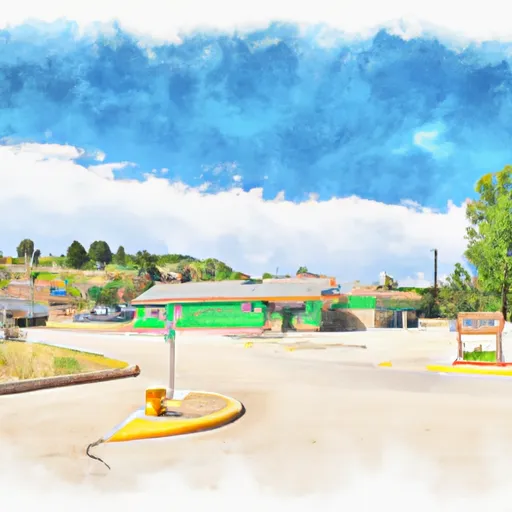-
 Snoflo Premium
Snoflo Premium
Get unlimited access to all our content
With no Ad interruptions! - Start Your Free Trial Login with existing account
Mc-Kinnon
Eden Index
Climate
7.1
•
Recreation
4.0
•
Community
•
Safeguard
4.2/10

McKinnon, Wyoming is a small unincorporated community located in the southwestern part of the state, close to the Utah border. The climate in McKinnon is classified as semi-arid, with cold winters and hot summers. The area experiences low precipitation throughout the year, with an average annual rainfall of around 10 inches.
Hydrology in McKinnon is primarily influenced by the nearby Blacks Fork River, a tributary of the Green River. The river provides important water resources for the community and supports various aquatic species. Additionally, there are several small lakes and ponds in the area that offer opportunities for fishing and water-based activities.
Outdoor recreation is abundant in McKinnon, with its close proximity to vast natural areas. The surrounding landscape is characterized by rugged mountains, rolling hills, and vast grasslands. This makes the area ideal for activities such as hiking, camping, and wildlife viewing. Hunting is also popular in the nearby Bridger-Teton National Forest, which offers a diverse range of game species.
In summary, McKinnon, Wyoming offers a semi-arid climate, with low precipitation and distinct seasons. Its hydrology is influenced by the Blacks Fork River, providing essential water resources. The area provides ample opportunities for outdoor recreation, including fishing, hunting, hiking, and camping.
What is the Eden Index?
The Snoflo Eden Index serves as a comprehensive rating system for regions, evaluating their desirability through a holistic assessment of climate health, outdoor recreation opportunities, and natural disaster risk, acknowledging the profound impact of these factors on livability and well-being.
Climate Health Indicator (CHI): 7.1
Mc-Kinnon receives approximately
267mm of rain per year,
with humidity levels near 69%
and air temperatures averaging around
7°C.
Mc-Kinnon has a plant hardyness factor of
5, meaning
plants and agriculture in this region thrive during a short period during spring and early summer. Most
plants will die off during the colder winter months.
By considering the ideal temperature range, reliable water supplies, clean air, and stable seasonal rain or snowpacks, the Climate Health Indicator (CHI) underscores the significance of a healthy climate as the foundation for quality living.
A healthy climate is paramount for ensuring a high quality of life and livability in a region, fostering both physical well-being and environmental harmony. This can be characterized by ideal temperatures, reliable access to water supplies, clean air, and consistent seasonal rain or snowpacks.
Weather Forecast
Streamflow Conditions
Upper Green
Area Rivers
Upper Green
Snowpack Depths
Upper Green
Reservoir Storage Capacity
Upper Green
Groundwater Levels
Recreational Opportunity Index (ROI): 4.0
The Recreational Opportunity Index (ROI) recognizes the value of outdoor recreational options, such as parks, hiking trails, camping sites, and fishing spots, while acknowledging that climate plays a pivotal role in ensuring the comfort and consistency of these experiences.
Access to outdoor recreational opportunities, encompassing activities such as parks, hiking, camping, and fishing, is crucial for overall well-being, and the climate plays a pivotal role in enabling and enhancing these experiences, ensuring that individuals can engage in nature-based activities comfortably and consistently.
Camping Areas
| Campground | Campsites | Reservations | Toilets | Showers | Elevation |
|---|---|---|---|---|---|
| East Park | 21 | 9,050 ft | |||
| Greens Lake - Flaming Gorge | 20 | 7,467 ft | |||
| Red Fleet State Park | 31 | 5,719 ft | |||
| Red Canyon - Flaming Gorge | 8 | 7,420 ft | |||
| Oaks Park | 11 | 9,277 ft | |||
| Firefighters Memorial - Flaming Gorge | 94 | 6,861 ft | |||
| Lodgepole | 35 | 8,082 ft | |||
| Canyon Rim - Flaming Gorge | 15 | 7,439 ft | |||
| Cedar Springs - Flaming Gorge | 21 | 6,140 ft | |||
| Greendale - Flaming Gorge | 8 | 6,998 ft |
Catastrophe Safeguard Index (CSI):
The Catastrophe Safeguard Index (CSI) recognizes that natural disaster risk, encompassing floods, fires, hurricanes, and tornadoes, can drastically affect safety and the overall appeal of an area.
The level of natural disaster risk in a region significantly affects safety and the overall livability, with climate change amplifying these risks by potentially increasing the frequency and intensity of events like floods, fires, hurricanes, and tornadoes, thereby posing substantial challenges to community resilience and well-being.
Community Resilience Indicator (CRI):
The Community Resilience Indicator (CRI) recognizes that education, healthcare, and socioeconomics are crucial to the well-being of a region. The CRI acknowledges the profound impact of these elements on residents' overall quality of life. By evaluating educational resources, healthcare accessibility, and economic inclusivity, the index captures the essential aspects that contribute to a thriving community, fostering resident satisfaction, equity, and social cohesion.

